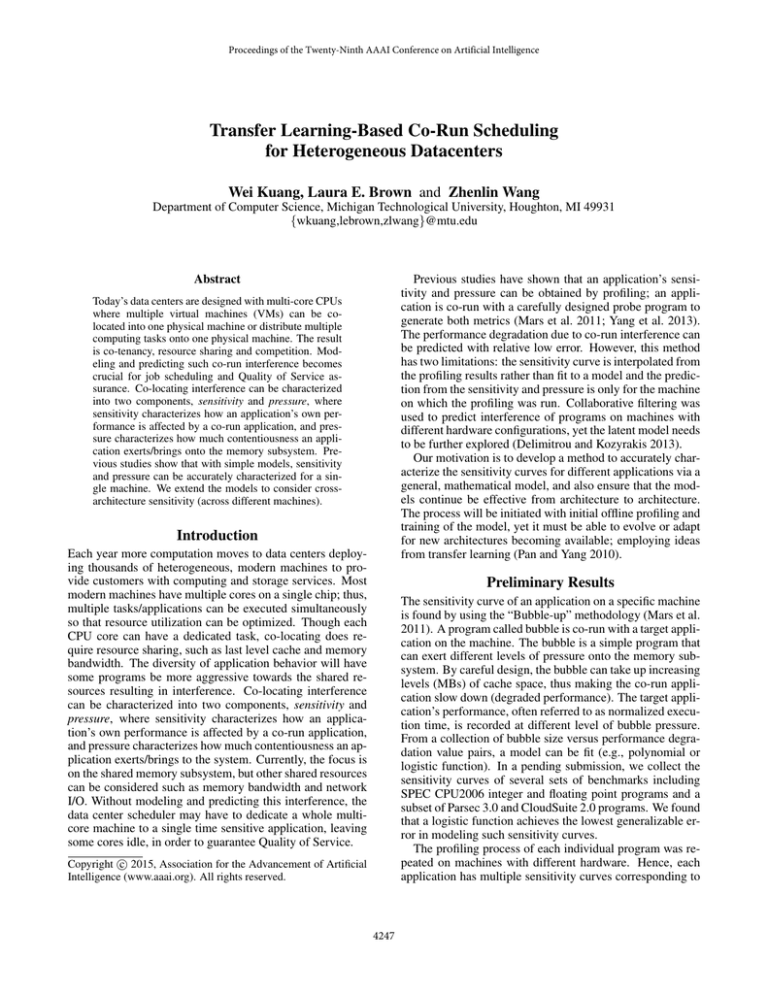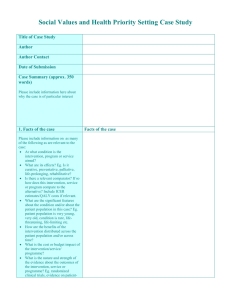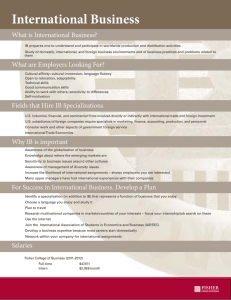
Proceedings of the Twenty-Ninth AAAI Conference on Artificial Intelligence
Transfer Learning-Based Co-Run Scheduling
for Heterogeneous Datacenters
Wei Kuang, Laura E. Brown and Zhenlin Wang
Department of Computer Science, Michigan Technological University, Houghton, MI 49931
{wkuang,lebrown,zlwang}@mtu.edu
Abstract
Previous studies have shown that an application’s sensitivity and pressure can be obtained by profiling; an application is co-run with a carefully designed probe program to
generate both metrics (Mars et al. 2011; Yang et al. 2013).
The performance degradation due to co-run interference can
be predicted with relative low error. However, this method
has two limitations: the sensitivity curve is interpolated from
the profiling results rather than fit to a model and the prediction from the sensitivity and pressure is only for the machine
on which the profiling was run. Collaborative filtering was
used to predict interference of programs on machines with
different hardware configurations, yet the latent model needs
to be further explored (Delimitrou and Kozyrakis 2013).
Our motivation is to develop a method to accurately characterize the sensitivity curves for different applications via a
general, mathematical model, and also ensure that the models continue be effective from architecture to architecture.
The process will be initiated with initial offline profiling and
training of the model, yet it must be able to evolve or adapt
for new architectures becoming available; employing ideas
from transfer learning (Pan and Yang 2010).
Today’s data centers are designed with multi-core CPUs
where multiple virtual machines (VMs) can be colocated into one physical machine or distribute multiple
computing tasks onto one physical machine. The result
is co-tenancy, resource sharing and competition. Modeling and predicting such co-run interference becomes
crucial for job scheduling and Quality of Service assurance. Co-locating interference can be characterized
into two components, sensitivity and pressure, where
sensitivity characterizes how an application’s own performance is affected by a co-run application, and pressure characterizes how much contentiousness an application exerts/brings onto the memory subsystem. Previous studies show that with simple models, sensitivity
and pressure can be accurately characterized for a single machine. We extend the models to consider crossarchitecture sensitivity (across different machines).
Introduction
Each year more computation moves to data centers deploying thousands of heterogeneous, modern machines to provide customers with computing and storage services. Most
modern machines have multiple cores on a single chip; thus,
multiple tasks/applications can be executed simultaneously
so that resource utilization can be optimized. Though each
CPU core can have a dedicated task, co-locating does require resource sharing, such as last level cache and memory
bandwidth. The diversity of application behavior will have
some programs be more aggressive towards the shared resources resulting in interference. Co-locating interference
can be characterized into two components, sensitivity and
pressure, where sensitivity characterizes how an application’s own performance is affected by a co-run application,
and pressure characterizes how much contentiousness an application exerts/brings to the system. Currently, the focus is
on the shared memory subsystem, but other shared resources
can be considered such as memory bandwidth and network
I/O. Without modeling and predicting this interference, the
data center scheduler may have to dedicate a whole multicore machine to a single time sensitive application, leaving
some cores idle, in order to guarantee Quality of Service.
Preliminary Results
The sensitivity curve of an application on a specific machine
is found by using the “Bubble-up” methodology (Mars et al.
2011). A program called bubble is co-run with a target application on the machine. The bubble is a simple program that
can exert different levels of pressure onto the memory subsystem. By careful design, the bubble can take up increasing
levels (MBs) of cache space, thus making the co-run application slow down (degraded performance). The target application’s performance, often referred to as normalized execution time, is recorded at different level of bubble pressure.
From a collection of bubble size versus performance degradation value pairs, a model can be fit (e.g., polynomial or
logistic function). In a pending submission, we collect the
sensitivity curves of several sets of benchmarks including
SPEC CPU2006 integer and floating point programs and a
subset of Parsec 3.0 and CloudSuite 2.0 programs. We found
that a logistic function achieves the lowest generalizable error in modeling such sensitivity curves.
The profiling process of each individual program was repeated on machines with different hardware. Hence, each
application has multiple sensitivity curves corresponding to
c 2015, Association for the Advancement of Artificial
Copyright Intelligence (www.aaai.org). All rights reserved.
4247
Our group has done significant preliminary work on locality modeling, cache partitioning, memory management, migration and remote memory in the system side. We also have
extensive experience in machine learning. This thesis work
examines the use and design of machine learning methods
to the systems domain to predict memory resource demand
and cache pressure. In particular, for the cross-architecture
prediction problems, transfer learning is examined.
Two initial frameworks for the problem are to be explored.
For the first, detailed source domain(s) data will be available,
that is extensive profiling will be collected on older hardware
configurations. The focus is to improve prediction accuracy
and require limited profiling of applications on any new target architectures added to the data center. For this framework, initial inductive transfer learning methods that employ
a parameter-transfer approach will be considered. The second framework will consider an active, or lifelong learning
design, so that new applications and/or architectures will be
continually added to the system (Eaton and Ruvolo 2013).
Both frameworks will make use of an extensive library of
profiled benchmarks on different machine architectures. The
estimated generalization performance of the models will be
confirmed with tests on a realistic environment in a data center. The models will be incorporated into the Xen virtual machine hypervisors and a comprehensive set of benchmarks
will be co-run to validate the results and refine our models.
Figure 1: Framework for cross-architecture prediction
different hardware configurations. The program pressure
was also profiled across machines. By observing the collected data, we found that both sensitivity curve and pressure
of a program will behave differently on different machines.
Therefore, we cannot predict performance interference for a
specific machine from the model generated by another machine with dissimilar hardware.
Nevertheless, we found that sensitivity curve and pressure
of applications can be estimated on a new machine without
extensive profiling and training. A relationship between the
parameters of the sensitivity curves was estimated. Therefore, the framework of our co-run performance prediction
system is as follows (see Fig. 1). With a base hardware configuration, and an abundance of benchmark programs representing different types of applications, we could do exhaustive off-line profiling and training. Whenever a new
hardware configuration is added, we only do profiling for
a small subset of benchmark programs and find the crossarchitecture relations between parameters. Thus, any application’s sensitivity curve can be recovered through the parameters of function obtained from the baseline machine.
The same design is followed to find relations of pressure.
We test this approach with SPEC CPU2006 benchmarks
as the training set, and Parsec 3.0 and CloudSuite 2.0 as the
test set with a Core2 Duo as the base hardware and Intel i5 as
the new machine. The predicted co-run performance degradation using the cross-architecture functions for sensitivity
curves and pressure has a mean relative error of <2%.
Conclusion
We describe a method to help a data center assign tasks with
high utilization while maintain QoS requirements. Based on
our experimental results, an application’s sensitivity curve
can be characterized by a logistic function. Furthermore,
the parameters of the sensitivity functions for different machines are related. Transfer learning will be explored to help
shorten both profiling and training time and online model
updating examined as there will always be new applications
and architectures arriving in a data center.
Acknowledgments
This material is based upon work supported by the National
Science Foundation under Grant No. 1422342 and 0643664.
References
Delimitrou, C., and Kozyrakis, C. 2013. Paragon: Qosaware scheduling for heterogeneous datacenters. In ASPLOS
’13, 77–88.
Eaton, E., and Ruvolo, P. L. 2013. Ella: An efficient lifelong
learning algorithm. In ICML-13, volume 28, 507–515.
Mars, J.; Tang, L.; Hundt, R.; Skadron, K.; and Souffa, M. L.
2011. Bubble-up increasing utilization in modern warehouse
scale computers via sensible co-locations. In MICRO-44.
Pan, S. J., and Yang, Q. 2010. A survey on transfer learning.
IEEE TKDE 22(10):1345–1359.
Yang, H.; Breslow, A.; Mars, J.; and Tang, L. 2013. Bubbleflux: Precise online qos management for increased utilization in warehouse scale computers. In ISCA ’13, 607–618.
Current Focus
The preliminary work piloted the idea of co-run sensitivity
learning across architectures, yet generalizations and extensions to this idea need exploration. For example, the crossarchitecture relationship between sensitivity curves can be
learned for specific machines, but is not a general model
that is based on hardware configuration information, e.g.,
last level cache size, L2 cache, etc. Additionally, an application’s pressure will change between different machines. A
uniform model (polynomial, logistic) may not closely characterize these variations. What other features may be incorporated into the models to explain these variations?
4248







